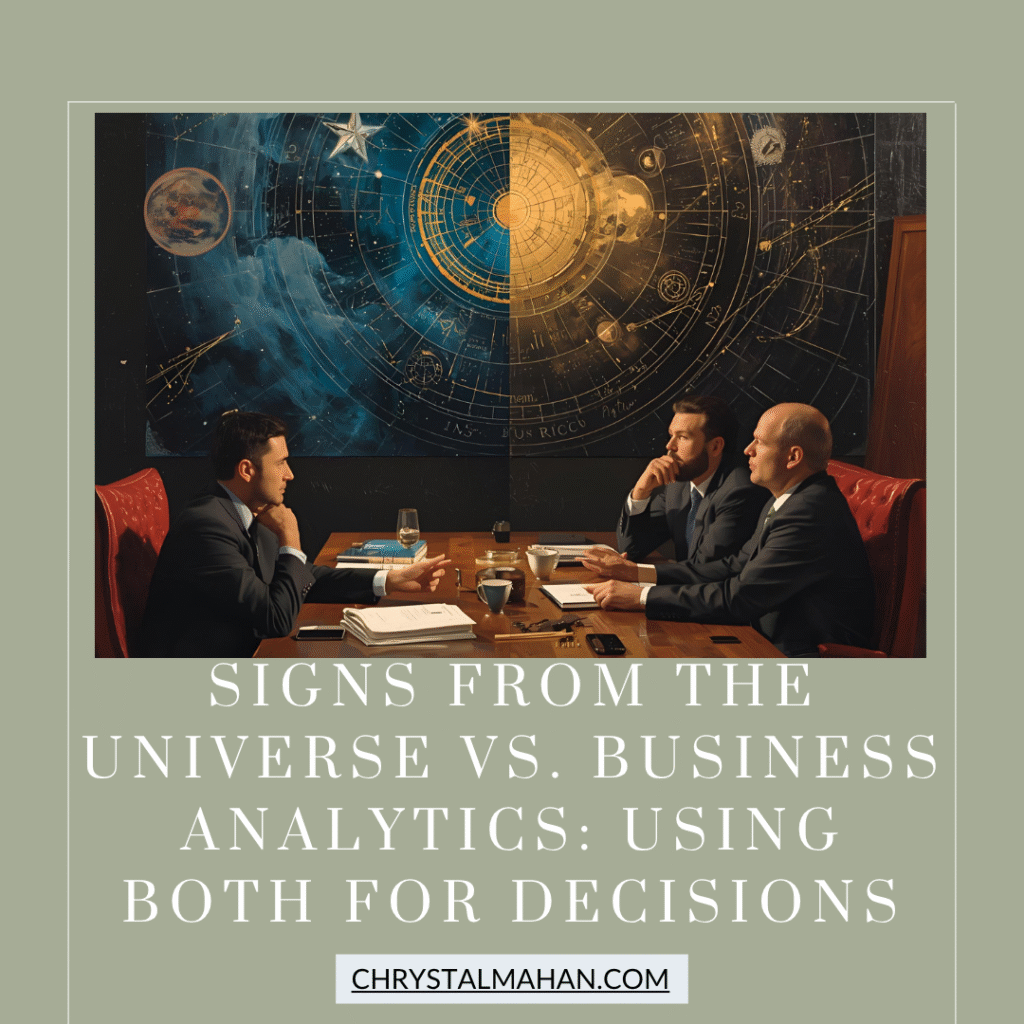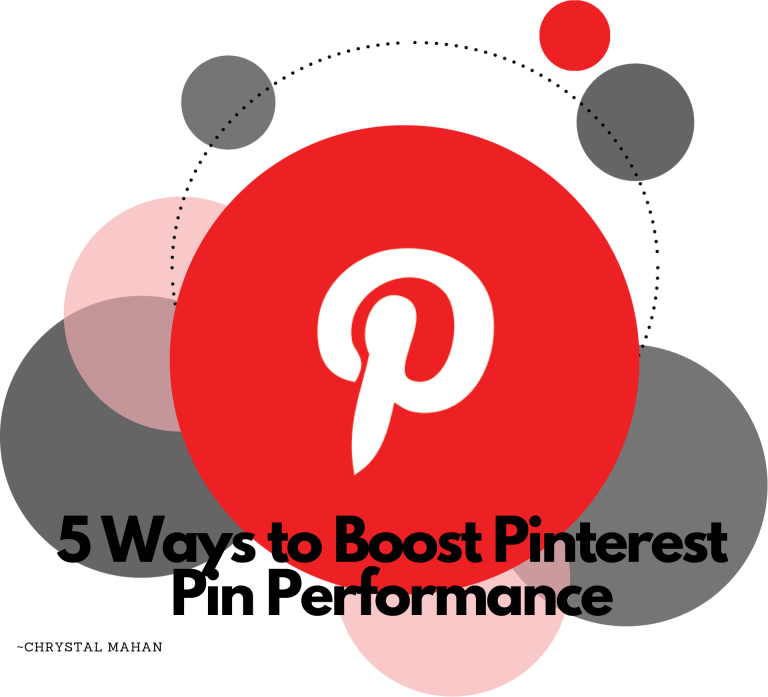Signs from the Universe vs. Business Analytics: Using Both for Decisions


You’re staring at your laptop at 11 PM, toggling between your analytics dashboard and that persistent feeling in your gut that won’t go away. The numbers say one thing. Your intuition whispers something entirely different. And you’re stuck wondering which voice to trust when the stakes feel impossibly high.
Here’s what nobody tells you about running a business: the most successful entrepreneurs aren’t choosing between data and intuition. They’re learning to speak both languages fluently. They’re reading spreadsheets in the morning and paying attention to synchronicities in the afternoon. They’re building systems that honor both the measurable and the mysterious, and they’re making decisions that feel as good as they look on paper.
This isn’t about abandoning your analytics for angel numbers or ignoring your instincts for metrics. It’s about recognizing that your business exists at the intersection of strategy and spirit, and the most powerful decisions happen when you stop treating these approaches as opposites. When you learn to integrate both perspectives, you create a decision making framework that’s more complete, more confident, and more aligned with both your goals and your values.
Why Business Owners Feel Torn Between Data and Intuition
The tension between analytical thinking and intuitive knowing didn’t start with your business. It’s been built into our professional culture for decades. We’ve been taught that “real” business runs on numbers, that feelings are unprofessional, and that any decision worth making should be backed by quantifiable proof. Meanwhile, we’re also hearing that the most innovative leaders trust their gut, that intuition separates good entrepreneurs from great ones, and that sometimes you just have to take a leap of faith.
No wonder you feel conflicted. You’ve invested in tools that track every click, conversion, and customer behavior. You’ve learned to read your metrics, understand your KPIs, and make data informed choices. But then there are those moments when everything in you says to pivot, even when the spreadsheet suggests staying the course. Or when the numbers point in one direction, but something feels off about the timing. These aren’t contradictions. They’re invitations to develop a more sophisticated approach to decision making.
The real problem isn’t that you’re receiving mixed signals. It’s that you’ve been operating under the false assumption that you have to choose one or the other. Business analytics show you what’s happening and what’s likely to happen based on patterns and trends. Intuitive signs help you recognize opportunities that haven’t shown up in your data yet, alert you to timing considerations that numbers can’t capture, and keep you aligned with your deeper purpose. Both matter. Both are valid. And both become exponentially more powerful when you stop pitting them against each other.
What most business owners don’t realize is that the entrepreneurs who seem to have an uncanny sense for making the right call aren’t actually choosing intuition over analysis. They’ve developed the skill of integration. They’re using their analytics to inform their intuition and their intuition to ask better questions of their data. They’re creating a feedback loop where both approaches strengthen each other, leading to decisions that are simultaneously smart and aligned.
How to Read Business Analytics Without Losing Your Intuitive Edge
Your analytics dashboard tells a story, but it’s not the whole story. Learning to read data effectively means understanding what your numbers can and cannot tell you. Revenue trends show you what’s working financially. Traffic patterns reveal where your audience is coming from and what captures their attention. Conversion rates indicate how well your messaging resonates with your ideal clients. These metrics are incredibly valuable, but they’re also historical. They tell you what happened, not necessarily what should happen next.
The key to using analytics without becoming enslaved to them is context. A number without context is just a number. When you see a dip in website traffic, your analytics might show you the decline, but they won’t automatically tell you whether it’s because of a seasonal shift, a change in your content strategy, a technical issue, or a larger market trend. This is where your intuitive read on your business becomes essential. You know the subtle changes you’ve been making, the energy shifts you’ve been feeling, and the external factors that might be influencing your numbers.
Strong analytical skills actually enhance your intuition rather than replace it. When you understand what you’re measuring and why it matters, you can ask more sophisticated questions. Instead of just noticing that engagement is down, you can dig into whether it’s down across all platforms or just one. You can check whether it’s affecting all content types equally or if certain topics are still resonating. You can look at the timing of the decline and consider what else was happening in your business or your industry during that period. This deeper analysis often reveals patterns that trigger your intuitive recognition of what’s really going on.
The practice of working with analytics while maintaining your intuitive connection requires a specific kind of attention. Look at your numbers regularly enough that you develop a feel for what’s normal in your business. When something shifts, you’ll recognize it not just intellectually but energetically. Pay attention to which metrics make your stomach drop and which ones make you light up, even when the numbers themselves seem neutral. Your emotional and physical responses to data are forms of intuition. They’re your system’s way of processing complex information faster than your conscious mind can analyze it.
Recognizing Signs from the Universe in Your Business Journey
Signs from the universe show up differently in a business context than they might in your personal life, but they’re no less real or valuable. They often appear as patterns, synchronicities, or persistent thoughts that won’t leave you alone. You might keep seeing the same topic mentioned across different platforms, suggesting it’s time to create content around that theme. You might have three potential clients in one week mention the same pain point you hadn’t been addressing. You might wake up with a solution to a problem you’d been struggling with for months.
The challenge with recognizing these signs is learning to distinguish between genuine intuitive guidance and anxiety, wishful thinking, or fear dressed up as insight. Real intuitive hits tend to have a quality of clarity and calm, even when they’re pushing you toward something that feels risky. They often come with a sense of rightness that’s hard to articulate but impossible to ignore. Fear based thoughts, on the other hand, usually feel urgent, scattered, and accompanied by worst case scenarios. They push you to make decisions from a place of lack rather than possibility.
Timing is one of the most common ways the universe communicates in business. You might have been considering a particular strategy for months, but suddenly everything aligns to make it happen now. A collaborator reaches out at exactly the right moment. A resource you need becomes available. A client asks for something you’d been thinking about creating. These aren’t random coincidences. They’re confirmations that you’re moving in sync with something larger than your individual planning.
Physical and emotional responses are another form of universal guidance that many entrepreneurs overlook. That feeling of expansion in your chest when you talk about a new offering isn’t just excitement. It’s information. The way your energy drops when you consider continuing with a particular client or project isn’t just fatigue. It’s guidance. Your body knows things before your mind catches up, and learning to read these somatic signals adds another layer of intelligence to your decision making process.
Creating a Decision Making Framework That Honors Both Approaches
Integration starts with acknowledging that you don’t have to choose. The most powerful framework for business decisions creates space for both analytical rigor and intuitive wisdom. This means developing a process that deliberately includes both perspectives rather than defaulting to whichever one feels most comfortable or most acceptable to the business culture you’re operating in.
Start by gathering your data. Before you make any significant decision, know what your numbers are telling you. What does your financial situation look like? What are your current conversion rates? How engaged is your audience? What capacity do you actually have? Get clear on the objective information available to you. This isn’t about letting the numbers make the decision for you. It’s about being informed so that your intuition has solid ground to work with.
Next, create space for intuitive input. This might mean taking a walk without your phone, journaling about the decision, or simply sitting quietly and noticing what comes up. Ask yourself what feels aligned, not just what makes logical sense. Pay attention to your body’s responses. Notice what you’re drawn to versus what you think you should do. Let yourself consider possibilities that might not have obvious data to support them yet. Some of the best business decisions come from sensing an opportunity before it shows up in your analytics.
The magic happens in the dialogue between these two perspectives. When your data and your intuition align, you have a clear green light. When they seem to conflict, you have important information. Maybe your intuition is picking up on a timing issue that will show up in your data later. Maybe your data is showing you a pattern that your intuition hadn’t fully acknowledged yet. Maybe there’s a third option you haven’t considered that would satisfy both perspectives. The conflict isn’t a problem to solve. It’s an invitation to look deeper.
Practical Applications for Everyday Business Decisions
Small decisions benefit from this integrated approach just as much as major pivots do. When you’re deciding whether to publish a particular piece of content, check your data on what topics have performed well for you historically. Then check in with your intuition about whether this particular piece feels aligned right now. The combination might lead you to publish it, hold it for better timing, or adjust the angle to better match both your audience’s demonstrated interests and your current energetic alignment.
Pricing decisions often create tension between what the market seems to dictate and what feels right to you. Your analytics can show you what price points convert best, what your audience has been willing to pay, and what your time and expertise are worth mathematically. Your intuition knows when you’re undercharging because you’re scared, when you’re overcharging because you’re trying to prove something, and when you’ve hit a number that reflects true value exchange. Use both. Look at the data, then feel into what pricing structure allows you to show up fully for your clients while building a sustainable business.
Hiring and collaboration decisions require both due diligence and energetic alignment. You can review someone’s portfolio, check their references, and verify their skills. These are essential analytical steps. But you also need to notice how you feel in conversation with them, whether their energy matches your business’s needs right now, and whether something in you lights up or contracts at the thought of working together. The best team members usually feel right in both dimensions.
Marketing strategy becomes more effective when you blend data driven insights with intuitive timing. Your analytics might tell you that video content performs better than static posts, that your audience engages most on Tuesday afternoons, and that certain topics drive the most shares. Your intuition might tell you that this particular week, your people need something more vulnerable and less polished, or that there’s a message you need to share even though it doesn’t fit your usual content calendar. Honor both. Use your data to inform your baseline strategy, and use your intuition to navigate the nuances of when and how to execute it.
When to Trust Each Source of Information More Heavily
Some decisions naturally lean more toward one type of intelligence than the other. Financial decisions typically require heavier reliance on data. If you’re deciding whether you can afford to hire a new team member, your cash flow projections, revenue trends, and capacity analysis matter more than whether it feels expansive. You still check in with your intuition about timing and fit, but you don’t use good vibes to override negative numbers. The data grounds you in reality and protects you from making financially unsustainable choices based solely on hope.
Creative and strategic direction, on the other hand, often requires trusting your intuition more heavily. When you’re deciding which direction to take your brand, what new offerings to develop, or how to position yourself in the market, the data can inform you about what’s worked before and what your audience has responded to. But it can’t tell you where you’re growing next or what wants to emerge through your business. These decisions require you to sense into what feels aligned with your vision and values, even when you don’t have proof yet that it will work.
Timing decisions almost always benefit from intuitive weight. Your analytics might show you that launching a new program would make logical sense based on audience interest and market conditions. But if your intuition is screaming that the timing is off, listen. You might be picking up on energy in your industry that hasn’t shown up in data yet. You might be sensing that your own capacity isn’t where it needs to be. You might be aware of personal factors that will affect your ability to show up fully. Trust the timing, even when the logic seems sound.
Relationship based decisions require a balanced approach that leans slightly toward intuition. Whether you’re deciding to continue working with a challenging client, partner with another business, or invest in a mentor or coach, the data matters. You need to know whether the financial arrangement makes sense, whether the time investment is sustainable, and whether there’s evidence of mutual benefit. But relationships are fundamentally energetic, and your intuitive read on trustworthiness, alignment, and long term potential often matters more than what you can measure.
Moving Forward with Integrated Intelligence
The practice of integrating analytical and intuitive intelligence isn’t something you master and complete. It’s an ongoing refinement of how you process information, make choices, and navigate your business journey. Each decision you make using both approaches teaches you something about how they work together in your specific context. You learn which signs tend to be most reliable for you. You discover which metrics most accurately predict outcomes in your business. You develop a personalized decision making language that honors both dimensions.
Start simple if this feels overwhelming. Choose one decision you’re currently facing and deliberately invite both perspectives to the table. Look at what the data says. Sit with what your intuition knows. Notice where they agree and where they diverge. Make your choice from that integrated place and observe what happens. You’re not looking for perfection. You’re building a new muscle, and like any skill, it strengthens with practice.
Remember that this approach isn’t about making everything complicated or second guessing yourself constantly. It’s actually about making decisions with more confidence because you’re drawing on multiple sources of intelligence. You’re not ignoring your spreadsheets for mystical thinking, and you’re not suppressing your inner knowing for the appearance of being “data driven.” You’re being both. You’re being whole.
The entrepreneurs who thrive long term are the ones who learn to work with reality as it actually is, not as we’ve been told it should be. Reality includes numbers and patterns and trends. It also includes intuition and synchronicity and the mysterious timing of things. Your business gets to be a place where both are welcome, where both are valued, and where both inform how you move forward. That integration isn’t just possible. It’s the most natural way to make decisions when you stop forcing yourself to choose between two essential forms of knowing.
What Integration Looks Like in Your Business
When you successfully integrate analytical and intuitive approaches, decision making starts to feel different. There’s less internal conflict because you’re not constantly choosing between two parts of yourself. There’s more confidence because you’re drawing on multiple forms of intelligence. There’s better timing because you’re paying attention to both what the numbers suggest and what the energy indicates. Your business starts to flow more naturally because you’re working with all the information available to you rather than artificially limiting yourself to what can be measured.
You’ll notice that you make adjustments more quickly because you’re picking up on subtle shifts before they become obvious in your data. You’ll find that opportunities feel more aligned because you’re filtering them through both practical viability and intuitive resonance. You’ll experience less regret about your choices because even when outcomes don’t match your expectations, you know you made the best decision possible with all the intelligence you had access to at the time.
This integrated approach also tends to attract clients and opportunities that match your values more closely. When you’re making decisions from a place of wholeness rather than splitting yourself between logic and intuition, your external reality begins to reflect that integration. You naturally magnetize people and situations that honor both the strategic and the soulful aspects of business. Your marketing becomes more authentic because you’re not trying to fit into someone else’s formula. Your offers become more compelling because they emerge from genuine alignment rather than market research alone.
The work of integration never stops, but it does get easier. You develop trust in your ability to read both forms of information. You build confidence in your decision making process. You create a business that reflects not just best practices and market demands, but also your unique vision and values. This is where sustainable success lives. This is where you get to be fully yourself while building something that actually works.
Your business deserves the full spectrum of your intelligence. Your decisions deserve the depth that comes from honoring both what you can measure and what you can sense. The path forward isn’t about choosing between data and intuition. It’s about learning the language of both and letting them inform each other. That’s where the real magic happens. That’s where you build something that’s simultaneously strategic and soulful, grounded and inspired, practical and aligned.
Ready to explore more ways to build a business that honors both strategy and intuition? Browse through more posts on integrating systems and soul in your entrepreneurial journey. And if this conversation sparked something in you, I’d love to continue it over coffee. Reach out and let’s talk about how you can bring more integration and alignment into your business decisions.
Like what you read? Get in touch – let’s chat over virtual coffee.
~ Chrystal






